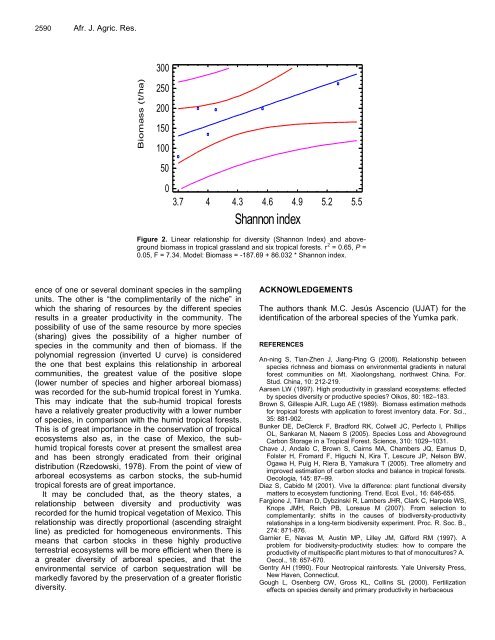Download Complete Issue - Academic Journals
Download Complete Issue - Academic Journals
Download Complete Issue - Academic Journals
Create successful ePaper yourself
Turn your PDF publications into a flip-book with our unique Google optimized e-Paper software.
2590 Afr. J. Agric. Res.<br />
Biomass (t/ha)<br />
300<br />
250<br />
200<br />
150<br />
100<br />
50<br />
0<br />
3.7 4 4.3 4.6 4.9 5.2 5.5<br />
Shannon index<br />
Figure 2. Linear relationship for diversity (Shannon Index) and aboveground<br />
biomass in tropical grassland and six tropical forests. r 2 = 0.65, P =<br />
0.05, F = 7.34. Model: Biomass = -187.69 + 86.032 * Shannon index.<br />
ence of one or several dominant species in the sampling<br />
units. The other is “the complimentarily of the niche” in<br />
which the sharing of resources by the different species<br />
results in a greater productivity in the community. The<br />
possibility of use of the same resource by more species<br />
(sharing) gives the possibility of a higher number of<br />
species in the community and then of biomass. If the<br />
polynomial regression (inverted U curve) is considered<br />
the one that best explains this relationship in arboreal<br />
communities, the greatest value of the positive slope<br />
(lower number of species and higher arboreal biomass)<br />
was recorded for the sub-humid tropical forest in Yumka.<br />
This may indicate that the sub-humid tropical forests<br />
have a relatively greater productivity with a lower number<br />
of species, in comparison with the humid tropical forests.<br />
This is of great importance in the conservation of tropical<br />
ecosystems also as, in the case of Mexico, the subhumid<br />
tropical forests cover at present the smallest area<br />
and has been strongly eradicated from their original<br />
distribution (Rzedowski, 1978). From the point of view of<br />
arboreal ecosystems as carbon stocks, the sub-humid<br />
tropical forests are of great importance.<br />
It may be concluded that, as the theory states, a<br />
relationship between diversity and productivity was<br />
recorded for the humid tropical vegetation of Mexico. This<br />
relationship was directly proportional (ascending straight<br />
line) as predicted for homogeneous environments. This<br />
means that carbon stocks in these highly productive<br />
terrestrial ecosystems will be more efficient when there is<br />
a greater diversity of arboreal species, and that the<br />
environmental service of carbon sequestration will be<br />
markedly favored by the preservation of a greater floristic<br />
diversity.<br />
ACKNOWLEDGEMENTS<br />
The authors thank M.C. Jesús Ascencio (UJAT) for the<br />
identification of the arboreal species of the Yumka park.<br />
REFERENCES<br />
An-ning S, Tian-Zhen J, Jiang-Ping G (2008). Relationship between<br />
species richness and biomass on environmental gradients in natural<br />
forest communities on Mt. Xiaolongshang, northwest China. For.<br />
Stud. China, 10: 212-219.<br />
Aarsen LW (1997). High productivity in grassland ecosystems: effected<br />
by species diversity or productive species? Oikos, 80: 182–183.<br />
Brown S, Gillespie AJR, Lugo AE (1989). Biomass estimation methods<br />
for tropical forests with application to forest inventory data. For. Sci.,<br />
35: 881-902.<br />
Bunker DE, DeClerck F, Bradford RK, Colwell JC, Perfecto I, Phillips<br />
OL, Sankaran M, Naeem S (2005). Species Loss and Aboveground<br />
Carbon Storage in a Tropical Forest. Science, 310: 1029–1031.<br />
Chave J, Andalo C, Brown S, Cairns MA, Chambers JQ, Eamus D,<br />
Folster H, Fromard F, Higuchi N, Kira T, Lescure JP, Nelson BW,<br />
Ogawa H, Puig H, Riera B, Yamakura T (2005). Tree allometry and<br />
improved estimation of carbon stocks and balance in tropical forests.<br />
Oecologia, 145: 87–99.<br />
Diaz S, Cabido M (2001). Vive la difference: plant functional diversity<br />
matters to ecosystem functioning. Trend. Ecol. Evol., 16: 646-655.<br />
Fargione J, Tilman D, Dybzinski R, Lambers JHR, Clark C, Harpole WS,<br />
Knops JMH, Reich PB, Loreaue M (2007). From selection to<br />
complementarily: shifts in the causes of biodiversity-productivity<br />
relationships in a long-term biodiversity experiment. Proc. R. Soc. B.,<br />
274: 871-876.<br />
Garnier E, Navas M, Austin MP, Lilley JM, Gifford RM (1997). A<br />
problem for biodiversity-productivity studies: how to compare the<br />
productivity of multispecific plant mixtures to that of monocultures? A.<br />
Oecol., 18: 657-670.<br />
Gentry AH (1990). Four Neotropical rainforests. Yale University Press,<br />
New Haven, Connecticut.<br />
Gough L, Osenberg CW, Gross KL, Collins SL (2000). Fertilization<br />
effects on species density and primary productivity in herbaceous

















